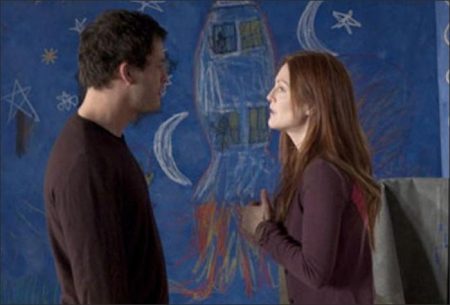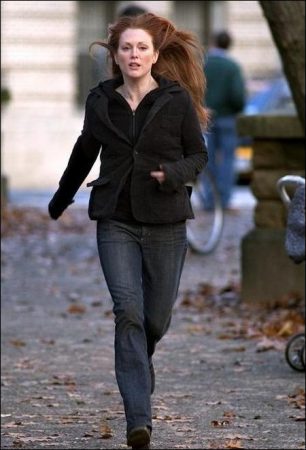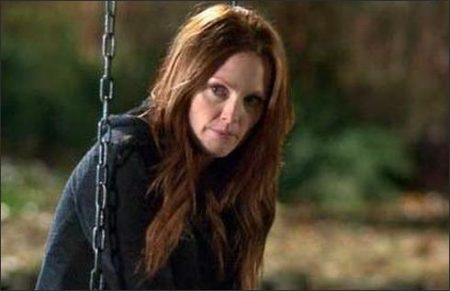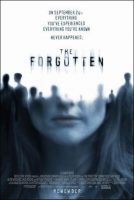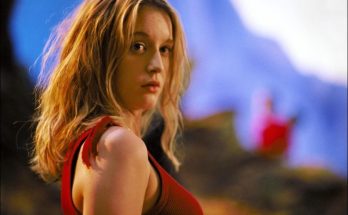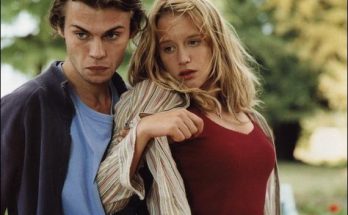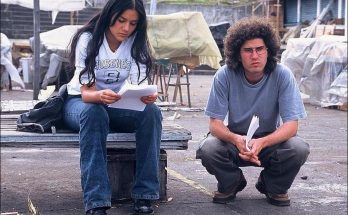The Forgotten Movie Trailer. In addition to Sleeping With the Enemy, Ruben has also directed the thrillers The Good Son and True Believer. It’s a genre for which he has an affinity and truly enjoys. “A good thriller can grab an audience like no other genre and that’s especially true of The Forgotten, which is riveting from the get-go, because you’re dealing with a woman who may or may not have had a son or is maybe having a psychotic breakdown. Either way she’s living a nightmare, but you don’t know whether the nightmare is in her head or real. The advantage of having an actress like Julianne Moore in the role is the air of realism and authenticity she brings to every part she plays.”
Academy Award-winning producers Bruce Cohen and Dan Jinks (American Beauty) are also avid fans of the genre. Says Cohen, “Dan and I had been wanting to do a thriller for a while, but we were hoping someday to find an unconventional thriller, something we hadn’t seen before, and with a couple of really intriguing elements. That’s a perfect description of The Forgotten. I kept turning the pages to find out what was going to happen next. It was riveting — and creepy.”
Executive producer Steve Nicolaides says Ruben was the ideal director to bring out all the subtext in the script. “Joe works very hard to get underneath a scene so that his actors can’t stay on the surface. That’s great for this kind of movie, because it’s really a character piece. He’s a very funny guy, he has a great selfdeprecating sense of humor, and everybody trusts his judgment and they love working with him. His first AD has done six or seven movies with him, the production designer the same, the script supervisor, three or four movies. He’s the kind of guy for whom everybody tries to give 120 percent.”
Ruben says the character of Telly Paretta “is a tour de force role, requiring an actor who can deliver on the possibility that the character may have had a psychotic breakdown, but at the same time the audience identifies with her and is completely behind her. Julianne has a quality that is so vivid and sympathetic that you can’t help but connect with her. As a real-life mother of two, you sense that in the performance she’s tapping into the unique bond that exists between a mother and her child.”
The casting of Moore gave producer Jinks a jolt as he read the script. “I knew Julianne was going to play Telly and I was imagining her reading these lines and the script just got scarier and scarier as I was reading it — especially because, for a period of time we don’t know whether she’s crazy, or if in fact she’s right and everybody else is wrong.”
Cohen adds, “Telly’s plight is one we can all identify with. It’s everyone’s worst nightmare — to wake up one day and find that the world is telling you everything you think is true is not true, and you’re not sure if you’re going crazy. We’ve all had those moments when we’ve been certain that our interpretation of the truth is right, yet other people have a completely different idea of what happened. Imagine not being able to find anyone to support your point of view. That’s a very scary, paranoid-inducing moment.”
Moore’s assessment of The Forgotten was sealed by the speed with which she tore through it. “I can always tell how I feel by how quickly I read a script,” she says. “I raced through this, thinking all along what a classic, exciting psychological thriller it was. I like movies that are quick, entertaining, scary, and fun. In addition, this one had a moving human element. The main issue was how we truly feel about our children, our family, our loved ones. That’s what made it truly engaging.”
She was also intrigued by the juxtaposition between Telly’s pragmatism and how her everyday life quickly unravels into chaos. “Telly is a resourceful, working mother, like many other mothers I know, who lives in Brooklyn Heights,” Moore continues. “I felt like I knew her, that I was her, that I have friends like her. So everything she does felt organic to me. She’s no more resourceful than anybody else would be in the same situation. She makes every effort to prove her son is real. And on this journey she tries to find others who can help her.”
Though she is turned away by others who suspect she may be delusional, Telly finally finds an ally in the dissolute, retired hockey player Ash Correll (Dominic West). They meet by chance at a playground where Telly believes her son Sam once played with Ash’s daughter Lauren.
The British-born West has been making rapid strides as a leading man over the past few years. Cohen recalls seeing him in the recent Broadway revival of Noel Coward’s classic triangular romantic comedy “Design for Living” with Alan Cumming and Jennifer Ehle and soon thereafter in a the riveting HBO dramatic series “The Wire.” Most recently he starred as a seductive professor in Mona Lisa Smile opposite Julia Roberts. All three roles demonstrate his considerable range, and in The Forgotten, says Cohen, “he really holds his own against Julianne.”
Moore knew just from reading opposite him that West was the right choice to play Ash. “A bunch of guys came in and read with me, and right away I knew Dominic was the one. He’s handsome, sexy, funny and really intense. He has that enviable ability to be very guy-like and also be incredibly emotional. And he makes it seem easy.”
For West, playing Ash Correll was a wonderful departure because, as he explains it, “I usually play the obnoxious boyfriend. If he’s English, then I play the drunk obnoxious boyfriend,” he laughs. “In this one I’m playing a drunk again, at least at the beginning, but then he turns into a bit of a hero. That’s something new for me. And he’s a good meaty hero as well, a man who has to struggle to change himself, to overcome impossible odds and emerge a decent guy.”
Like Telly, at the start of the film Ash is depressed and confused. “Something terrible has happened to him and he can’t quite make sense of it,” says West, adding that he tried to play against the stereotype of a professional athlete. “Ash has got all his teeth. He’s intelligent. He reads books. He’s a mess but he’s an interesting mess, which fuels the development of his relationship with Telly.”
The fact that The Forgotten is a great thriller was also instrumental in West’s decision to commit to the project. “Throughout the story, there’s mounting pressure against Telly and Ash from everyone around them. They’re in a nightmare situation where they remember something that no one else recalls. They’re living in a universe that no one recognizes and no one understands, which I suppose is a sort of madness.”
West enjoyed a fruitful working relationship with Ruben. “Joe’s great because he encourages you to think,” he says. “He’ll often drop in a pithy phrase, which instantly puts you into the scene and then let you go with it. And he’s immensely encouraging.”
The actor was no less impressed with Moore’s skills. “She’s incredibly good. I mean, she’ll be nattering on about something just before a take, and as soon as they call ‘Action!’ she’ll burst into tears or fume with anger. She can access those emotions instantly.”
The four other major roles were cast with actors of the same high caliber as Moore and West — Gary Sinise, Alfre Woodard, Anthony Edwards, and Linus Roache. Sinise, who was nominated for an Academy Award for his performance as Lt. Dan in Forrest Gump, plays Dr. Munce, the psychiatrist treating Telly. “Munce is unlike anybody I’ve played before,” says Sinise. “I usually play more visceral, aggressive characters. Munce is a very thoughtful guy, an introspective type, and that made it an interesting change of pace. Plus I got the opportunity to work with Julianne Moore, and that’s not terrible.”
The non-formulaic plot line was also a plus for Sinise, he says. “The unpredictability of the story is one of the things that got to me. A good psychological thriller can be a lot of fun because you never know who to trust or what’s going to happen until the very end.”
Woodard plays Ann Pope, a detective who becomes involved in Telly’s case. Before shooting started, Woodard spent time with a female detective in the N.Y.P.D. who told her that in cases where there is a woman involved, she immediately starts looking at the men around that woman. “She told me that very seldom do you need to go any further, like to a jealous sister or an irate neighbor,” says Woodard. “She said, ‘Just keep looking at the men close around her and you’re pretty much on the right track.’ She also tends to believe a woman, especially when she’s speaking from her heart. Telly of course is doing just that, no matter what’s going around her. Ann Pope is a facts-oriented type and she is open to what Dr. Munce tells her, but there is something about Telly crying out of her heart that gets to her. She doesn’t believe what all the men around her are saying. When a woman cries for her child, it’s hard to look past that or negate it.”
Edwards portrays Telly’s estranged husband Jim. He came aboard, he says, “because whenever I read a script and I don’t quite get it, I know there’s a lot more to it. It wasn’t an obvious story. I was always surprised by it. When it’s that much fun to read a script you assume it’ll be fun to watch as well.”
The role of Jim is tricky, says Edwards, because he is in direct opposition to Telly, but he must be credible and sympathetic at the same time. “He is certainly trying everything he can to help her because she’s really in a crisis. He thinks she’s going crazy. He’s genuinely scared because someone he knows very well is changing completely right before his eyes. That’s terrifying. If that happened to you in real life, you’d go through every possible emotion – anger, frustration, compassion, desperation.”
The British actor Linus Roache has the film’s most enigmatic role. His character is known simply as “The Friendly Man” because, says Roache, “he seems friendly, so that’s how the writer identified him. The best way to describe my character is that, like the movie, he has many dimensions. You think you’re in one kind of movie and then you find out actually you’re in another kind of movie, which is what made it so intriguing. But that’s all I’ll say about him. Any more information would ruin it.”
Developing the different levels of his character appropriately required a close collaboration with Ruben, says Roache. “You have to put your trust in the process and the way that Joe works. That doesn’t mean we sat around and talked about it for hours. We both worked on a kind of intuition, an instinct. Joe would joke with me, say things like, ‘What is your character about?’ I know he knows, and I know he understands the character’s function within the story, but instead of chewing that over, we just threw ourselves at it and trusted each other. It feels very organic. It was very freeing — and a lot of fun.”
About the Production
The city of New York is an uncredited character in The Forgotten. Production began in the fall in Brooklyn, in the recently gentrified neighborhood known locally as “Dumbo” (Down Under the Manhattan Bridge Overpass) — which is in fact between the Manhattan and Brooklyn Bridges. The area provided the exteriors for Ash Correll’s (Dominic West) apartment and that of several scenes built around a car and foot chase undertaken as Ash and Telly Paretta (Julianne Moore) flee the police. Overall, the film shot in numerous areas of Brooklyn and Manhattan as well as select locations in the Bronx and Queens. Other Brooklyn locations included townhouses in Brooklyn Heights and the western edge of Prospect Park.
The production spent several days in the Wall Street area of Manhattan at Chase Manhattan Plaza with its huge and distinctive Jean Dubuffet sculpture, “Group of Four Trees.” A scene that finds Telly in the Brooklyn Public Library was shot at the General Society Library on 44th Street in Manhattan, which is the second oldest continuously operating library in New York City, and one of only three private libraries left in Manhattan. Built in the 1890s, the library is an integral part of the General Society of Mechanics and Tradesmen of the City of New York.
There were also a few locations outside of New York City, including Harriman State Park in Rockland County, Westchester Airport in White Plains and two Long Island locations — a beach house in Hampton Bays and the dunes at Caumsett State Historic Park in Huntington.
Interiors were shot at the decommissioned Military Ocean Terminal in Bayonne, New Jersey, where numerous sets were built, including the inside of Ash’s apartment, a cottage, Dr. Munce’s house, a motel room, police headquarters, an airline office, the upstairs of Telly’s townhouse and a huge neglected hangar where the dramatic climax of the film takes place.
“Manhattan is a sort of ominous thing looking over the shoulder of Brooklyn, and it’s a character in this movie,’ says producer Dan Jinks. “That’s very much the kind of mood Joe Ruben was going for. In addition, we shot in the fall and winter when it’s bleak, cold, and scary looking, especially in Brooklyn.”
Producer Bruce Cohen concurs. “It was such a thrill for us to be shooting in New York. Unfortunately, over the years so many productions have gone to places like Canada, Australia, and even North Carolina for financial reasons. But in doing so, you lose the tangible atmosphere that only New York City can give you. The feeling that shooting in New York gives to the film adds to it immeasurably.”
Julianne Moore, who lives in New York City, was also a factor in the decision to shoot the film locally. “I live here, my children are in school here, and I did not want to go away,” she says. “But It was also important because the city is almost a character in the movie. I like the huge urban presence. It adds colors to the story.”
Linus Roache was also happy to be filming in New York. “Every American project I’ve done ended up shooting in Canada. So to actually shoot on American soil is fantastic, and New York is my favorite city in the world, so I loved it. I like the whole New York vibe — always have. Just being with a New York crew is really a lot of fun. There’s a great energy.”
Of course, shooting in New York meant having to factor its unpredictable weather into the equation. Nicolaides says, “The biggest challenge making the film was that the director and the head of the studio both wanted the movie to have a cold, winter look. We started at the end of October, a very volatile time of year weather-wise, since we’re going from fall into winter, yet the story takes place over the course of only two weeks. Therefore, what you start shooting in October, you’ll have to watch when you’re still shooting in January. The weather changes drastically from October to January in New York. That’s the hardest part of shooting here.
The “Dumbo” neighborhood was ideally suited to the look and tenor of The Forgotten, according to director Ruben. “We wanted to pick locations that had a slightly ‘off’ quality. ‘Dumbo’ was perfect because parts of the area are very desolate. All the varying shapes of the bridges and highways brought a dreamlike — and at times nightmarish — mood to the film. The street where Telly lives is basically an idyllic beautiful block, but it has that highway right behind it. So right from the beginning there’s a tension between those two locations. We chose Brooklyn partly because it’s less familiar, though Manhattan is close by, so you know exactly where you are.”
In planning out his approach to the film, Ruben drew up a set of visual rules and he and director of photography Anastas Michos largely adhered to them throughout. “I wanted it to be kind of cold, bleak and beautiful in general with warm light mainly when you’re in the kids’ rooms,” he says. “We used long lenses to give a feeling of paranoia and being watched, and very wide lenses to give a slightly distorted view of that world. We also had a couple of rules concerning color. The first was basically to keep it out of the movie except when showing the children. There was no red in the movie except for Julianne’s hair, so she would pop whenever she was on screen — which she does anyway.”
Adds Michos, “The visual style is basically realistic. Although we wanted the film to have a perspective — the sensation of being watched — we never deviated wildly from the feeling of heightened reality. I used a film stock I thought would give me the best latitude. I wanted to do a digital intermediate from the beginning, and our producers were very supportive. As far as lenses go, we used a standard Panavision Primo package but we pretty much stayed on the long end of the range. A 75mm lens was used for a lot of the master shots, and once we retreated way back and shot the master with a 300mm lens.”
Production designer Bill Groom was glad to be shooting in Brooklyn since he’s lived there for almost 20 years. “When I read the script it felt like Brooklyn to me,” says Groom, who has worked on all of Ruben’s films for the past decade. “We split this movie into two looks — the memory look, and the present-day. My feeling was always that given Telly’s emotional stress, her memories were more real to her, more vivid, than the present, because in the present she’s lost in the search for a child no one believes she ever had. Thus, her memories are in some ways the most concrete and the most real to her. Anastas also felt that the memory portions of the movie should be vivid and more colorful than the presentday scenes, which are mostly cast in fairly somber colors — not monochromatic, but very muted and much less intense than the colors in the memories.”
“I think this is a unique movie in that the locations we used in Brooklyn are presented as they actually are,” Groom continues. “This is the Brooklyn that people actually live in and that has charming, beautiful architecture. Brooklyn Heights has the largest collection of intact pre-Civil War houses of any neighborhood in the United States. It was one of the first landmark neighborhoods in the country. There is a whole middle to upper middle class world that exists in Brooklyn that most people — even New Yorkers — don’t know about. For a long time, Brooklyn was a well-kept secret and the people who lived there were happy that the rest of the country, including other New Yorkers knew nothing about it. It was like a retreat from the city, but close enough that you could walk to Manhattan across the Brooklyn Bridge. It’s a really interesting part of the city and this movie presents it as it really is.”
The Forgotten (2004)
Directed by: Joseph Ruben
Starring: Julianne Moore, Dominic West, Gary Sinise, Alfre Woodard, Anthony Edwards, Jessica Hecht, Linus Roache, Katie Cooper, Robert Wisdom, Alfre Woodard, Kathryn Faughnan
Screenplay by: Gerald Di Pego
Production Design by: Bill Groom
Cinematography by: Anastas N. Michos
Film Editing by: Richard Francis-Bruce
Costume Design by: Cindy Evans
Set Decoration by: Susan Bode
Art Direction by: Paul D. Kelly
Music by: James Horner
MPAA Rating: PG-13 for intense thematic material, some violence and brief language.
Distributed by: Columbia Pictures, Revolution Studios
Release Date: September 24, 2004
Views: 163
